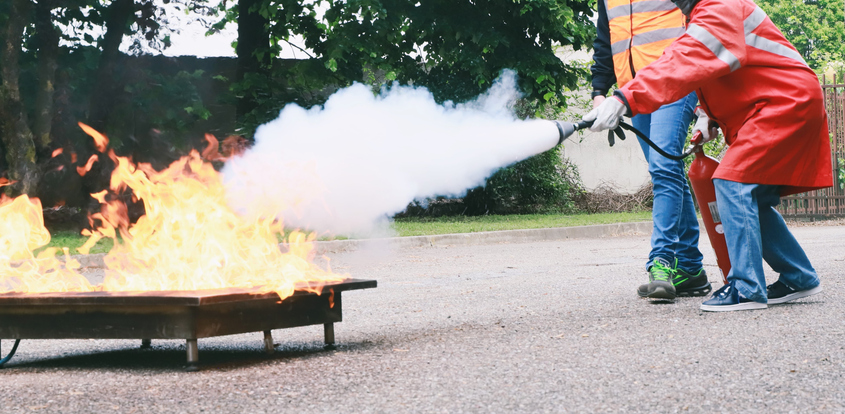Friday 8th November 2024
When it comes to fire safety, CO2 fire extinguishers are a popular choice for tackling fires involving electrical equipment and flammable liquid fires (class B). They’re effective and leave no messy residue, but they must be used correctly to ensure safety. Misuse of a CO2 fire extinguisher could be dangerous to the user or anyone nearby, with severe consequences.

The dangers of CO2 fire extinguishers
Easily recognised by their flute-shaped discharge horn, CO2 extinguishers are colour coded with a black label on the red extinguisher. While CO2 extinguishers can save lives in an emergency, if mishandled or used in the wrong situation they also pose the following potential risks.
Safety risks from CO2 extinguishers:
- Suffocation
- Frostbite / cold burns
- Visibility impairment
- High pressure release injury
CO2 displacing oxygen
A CO2 extinguisher works by displacing oxygen in the air, suffocating the fire since it cannot burn without oxygen. Discharging a CO2 extinguisher within a poorly ventilated area or confined space can affect people nearby. The displacing of oxygen and increase in CO2 can lead to suffocation or asphyxiation
Cold burns (frostbite) from gas or nozzle
CO2 is released from the extinguisher at extremely low temperatures, typically around -78°C (-109°F). Meaning that if either the gas or nozzle came into contact with skin, this would cause cold burns or frostbite. When ordering CO2 extinguishers, we recommend buying a CO2 extinguisher with a frost-free horn.
Pressure hazard
Carbon dioxide extinguishers are highly pressured (about 55 bar at room temperature). Therefore, if handled improperly, dropped or damaged, this could cause the extinguisher to explode or enable gas to escape suddenly.
Limited fire suppression capability
CO2 extinguishers are primarily suitable for fires involving flammable liquids (class B) and electrical equipment. Though CO₂ is cold when released, it is unsuitable for Class A fires involving solid combustibles like paper or wood. Class A fires require water-based extinguishers that penetrate/saturate the burning material to extinguish and prevent re-ignition. A smouldering Class A fire could re-ignite once the CO2 gas has dispersed.
How to safely use carbon dioxide extinguishers
In order to safely use a CO2 extinguisher, you should ensure that once the pin has been unlocked, the extinguisher is being held upright. Aim the nozzle at the base of the fire and avoid touching the horn. Squeeze the handle to release the CO2.
Once discharged, move to fresh air as soon as possible, away from the CO gas to avoid suffocation or visibility impairment. Prevent injuries by carefully handling the CO2 extinguisher to avoid damage and to prevent any accidental gas release.
Why are CO2 extinguishers useful?
CO2 extinguishers are useful as they have the ability to extinguish fires without causing damage to electrical equipment, also leaving no residue at the same time. This key quality means CO2 extinguishers are particularly valuable in server rooms or anywhere with a lot of expensive electrical equipment.
One drawback of CO2 extinguishers is they are unsuitable for class A fires (solid combustibles). However, in office or retail environments, they are often paired with a water extinguisher or foam extinguisher. In these cases, the CO2 handles electrical fires, while water or foam can be used to tackle class A fires. It’s common to see CO2 extinguishers alongside water or foam extinguishers, unless the fire risks are solely covered by the CO2.
Where are carbon dioxide extinguishers suitable for?
As CO2 fire extinguishers are suitable for fires involving electrical equipment, they are ideal for server rooms. These days CO2 extinguishers are mainly used in this type of environment as they leave no harmful residue that may contaminate sensitive circuitry. Please note, that the use of CO2 gas on electronics can still damage the circuits through static or temperature shock.

Should carbon dioxide extinguishers be used in offices?
CO2 extinguishers are generally not recommended as the primary choice for office use because they are not effective on class A fires. CO2 extinguishers are designed for Class B (flammable liquids) and electrical fires; however, most fire risks in office spaces are typically Class A and live electrical equipment. While CO2 is effective for electrical fires, these fires often ignite nearby combustible materials, escalating into a Class A fire. At this point, the CO2 extinguisher would not be effective for extinguishing the Class A fire, so a water-based extinguisher is generally required to safely put it out.
Water mist extinguishers that have been di-electrically tested are an ideal alternative in offices as they can handle all common office fire risks (including class A and live electrical equipment), allowing a single extinguisher at each fire point instead of two. This also reduces the risk of someone using the wrong extinguisher on a fire type, which could be very dangerous.
Call our team on 0800 612 6537 to discuss your fire extinguisher requirements or explore our website and see our impressive range of affordable fire safety products in greater detail.

 Safelincs supplies Handelsbanken, a leading Swedish Bank with over 700 branches in 24 countries, 147 branches of which are in the UK, with fire safety products such as fire extinguishers. Purchasing fire extinguishers from Safelincs gives Handelsbanken full protection. Should the extinguishers ever be used, Safelincs will immediately replace the extinguishers. So, when on the 21st of October a
Safelincs supplies Handelsbanken, a leading Swedish Bank with over 700 branches in 24 countries, 147 branches of which are in the UK, with fire safety products such as fire extinguishers. Purchasing fire extinguishers from Safelincs gives Handelsbanken full protection. Should the extinguishers ever be used, Safelincs will immediately replace the extinguishers. So, when on the 21st of October a